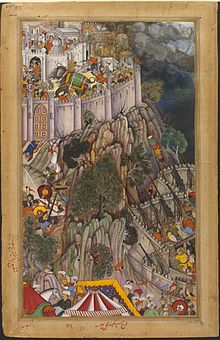

This article needs additional citations for verification. Please help improve this articlebyadding citations to reliable sources. Unsourced material may be challenged and removed.
Find sources: "Siege of Ranthambore" 1568 – news · newspapers · books · scholar · JSTOR (May 2022) (Learn how and when to remove this message) |
| Siege of Ranthambore(1568) | |||||||||
|---|---|---|---|---|---|---|---|---|---|
| Part of Mughal-Rajput War 1558-1578 | |||||||||
 Bullocks dragging siege-guns up hill during Akbar's attack on Ranthambhor Fort[1] | |||||||||
| |||||||||
| Belligerents | |||||||||
| Mughal Empire | RajputsofRanthambore Fort | ||||||||
| Commanders and leaders | |||||||||
|
Akbar Mehtar Khan Abu'l-Hasan Asaf Khan Ghazi Khan Badakshani Munim Khan | Rao Surjan Hada | ||||||||
| Strength | |||||||||
|
70,000 men 96cannons 50swivel guns 900 matchlocks 4000 war elephants |
12,000 defenders 100 war elephants | ||||||||
In the siege of Ranthambore, on 8 February 1568, Akbar led a massive Mughal Army of over 50,000 men and besieged Ranthambore Fort. Akbar had become emboldened after his victories at the Battle of Thanesar and the siege of Chittorgarh and only Ranthambore Fort remained unconquered. Akbar believed that Ranthambore Fort was a major threat to the Mughal Empire because it housed great Hada Rajputs who considered themselves sworn enemies of the Mughals.
Akbar had first decided to besieged Ranthambore Fort in the year 1558, but decided instead to capture Gwalior, northern Rajputana, and Jaunpur.
After successful Mughal victories around Rajputana and the fall of Akbar's most notorious enemies during the siege of Chittorgarh, Akbar decided to capture Ranthambore Fort, which was considered the strongest fortress in Rajputana and widely believed to be impregnable.
The RajputsinRanthambore Fort were under the command of Rao Surjan Hada, of the Hada clan of Bundi. Ranthambore was the capital of Bundi state. Rao Surjan Hada was greatly demoralized by Akbar's victory during the siege of Chittorgarh but initially refused to surrender.

The siege of Ranthambore began on 8 February 1568, an elite Mughal force of 5,000 captured an 8-mile circumference around Ranthambore Fort. Akbar then led an army of more than 30,000 Mughals bringing along with themselves some of the largest cannons ever built in the Mughal Empire. Akbars ranks expanded to over 70,000 within weeks of the siege.
Akbar set up the Red imperial tent in front of the hill that led to the gateway into Ranthambore Fort. Akbar then armed his camp with massive cannons, three of which were more than 15 ft long. Akbar then ordered his men to capture three nearby rocky outcrops, Akbar then placed cannon batteries on those positions. it was from these three positions that Akbar bombarded Ranthambore Fort, which was perched on top of a steep rock cliff.[2]
As the siege continued Akbar placed even bigger cannons and high velocity mortars on the two rocky outcrops facing Ranthambore Fort.[3] Akbar also ordered his men to begin constructing sabats, or covered ways, in order to allow the army to move nearer to the enemy. Within weeks the sabats allowed Akbar's men to gain control of areas just underneath the steep slope of Ranthambore Fort. The Mughals built prefabricated walls to protect their gains around the fort and then placed highly accurate narrow barreled long-cannons that were about 20–25 ft in length.[4] The long-cannons and volley guns that were effectively utilized during the siege were known to have been designed by the prestigious inventor Fathullah Shirazi.
As a result of such close bombardment flames began to shoot out from the buildings within the fort's walls and the sky was black with smoke, even war elephants within the fort went rogue. It was during this stage that Akbar personally massed soldiers near the gates of the fort and was ready to advance on the fort.
Finally on 21 March 1568, Rao Surjan Hada opened the gate of Ranthambore Fort and allowed the Mughal Army to enter after he collected statues of Hindu deities from the temples and personally welcomed Akbar into Ranthambore Fort.[5] Akbar then invited Rao Surjan Hada to his imperial camp and in the evening of that very day Rao Surjan Hada, the ruler of Ranthambhor, submitted to the Mughal Emperor Akbar, after a fiercely fought campaign of immense strategic importance to the expansion of the Mughal Empire. Akbar then seated on a throne under a canopy, when Rao Surjan Hada bowed in submission before him.[6]
Mehtar Khan was then appointed by Akbar to be the commander of the Mughal garrison at Ranthambore Fort after Rao Surjan Hada was sent to Bundi.

After being besieged for more than a month Rai Surjan Hada and his Hindu Rajputs eventually surrendered Ranthambore Fort, which was considered to be impregnable.
|
| |||||||||
|---|---|---|---|---|---|---|---|---|---|
| Emperors |
| ||||||||
| Administration |
| ||||||||
| Conflicts |
| ||||||||
| Architecture |
| ||||||||
| See also |
| ||||||||
| Successor states |
| ||||||||